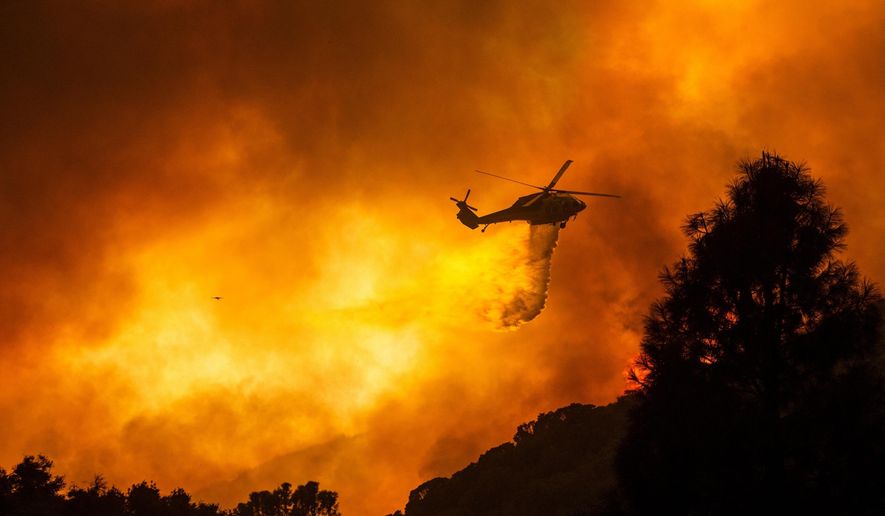Wildfire smoke made up 50% of small particle air pollution in the western regions of the U.S. and up to 25% across the nation, according to a new study.
Although pollution emissions from other sources such as vehicle exhaust have declined, particulate matter from fires has climbed substantially since the mid-2000s, when wildfire smoke contributed to less than 20% of emissions in the western regions a decade ago, said researchers from Stanford University and the University of California, San Diego.
“Large increases in wildfire activity have been accompanied by substantial increases in the number of days with any smoke in the air across the United States,” the researchers said in their study, released Monday. “Such increases have been observed throughout the continental United States, not just in the West, and threaten to undo the substantial improvements in air quality observed across the United States over the last two decades.”
The “fingerprints of wildfire” can be seen in the increasing spring and summertime organic carbon concentrations observed in rural areas of the southern and western regions of the U.S., says the study, published in the Proceedings of the National Academy of Sciences.
Researchers looked at satellite images of smoke plumes and information from pollution monitoring stations from 2016 to 2018 and data from a decade earlier to see how much pollution wildfires generated nationwide.
Between 2016 and 2018, wildfires burned about 24 million acres across the U.S., or an average of about 8 million acres each year, according to data from the National Interagency Fire Center (NIFC).
Close to the same amount of acreage was burned from 2006 to 2008. Preliminary data from 2020 shows that wildfires scorched nearly 10.3 million acres nationwide. However, from 2018 to 2020, wildfires burned about 24 million acres as well, NIFC data show.
Burned area from wildfires has roughly quadrupled in the United States over the past 40 years, which has been driven by the accumulation of fuels from fire suppression and an increase in dryness of climate and forests, the researchers said.
Along with these factors, the number of houses in the wildlandurban interface (WUI) also has grown. Researchers estimate that about 49 million homes are in these areas, a figure that has increased by about 350,000 houses each year for the last 20 years.
Although increases in air pollution from wildfire smoke are concentrated in the western states, the study authors note the long-distance transport of smoke from large fires has contributed to particulate matter in other regions such as the midwestern and eastern regions of the U.S.
Warmer temperatures are responsible for about half of the increase in burned areas in the U.S. and “future climate change could lead up to an additional doubling of wildfire-related particulate emissions in fire-prone areas or a manyfold increase in burned areas,” the researchers said.
“Across much of the western United States, the frequency of wildfires, and the sizes of wildfires, are projected to increase as climate continues to change,” said Erica Fleishman, director of Oregon Climate Change Research Institute who was not involved in the study. “The article is consistent with understanding from many scientific disciplines that the populations most affected by diverse environmental changes often are far from the sources of those changes.”
Fires in the western region have emitted more than a million tons of particulate pollution in 2012, 2015 and 2017 and almost that amount in 2018, The Associated Press reported.
In Kittitas County in central Washington, which was heavily impacted by wildfire smoke last September, researchers found a 100-fold increase in air pollution concentrations compared to prewildfire levels.
According to the pre-print in MedRxiv, environmental scientists from University of Washington found that each week of wildfire smoke exposure from 2020 would lead to about 88 more cases in allcause mortality, 19 more cardiovascular disease deaths, and nine more respiratory disease deaths.
“Wildfire smoke episodes are likely to continue impacting the West Coast in future years, so steps should definitely be taken to reduce exposures to wildfire smoke to avoid this excess health burden,” said Yisi Liu, one of the study’s authors.
Fine particles from smoke can cause a range of health issues such as burning eyes and a runny nose to aggravated chronic heart and lung diseases and possibly premature death.
• Shen Wu Tan can be reached at stan@washingtontimes.com.




Please read our comment policy before commenting.